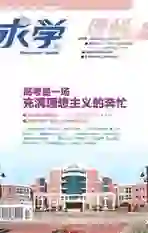“颠倒众生”之倒装句
2015-04-23周童瑜
周童瑜,南京大学博士,主要研究方向是国际关系和中美文化。托福考试满分获得者,知名语法专家,对英语语法有独到研究。
好好的句子,不使用正常语序,非要倒装,有时候英语表达为了强调,也是“蛮拼”的。这不,我们的考生就惨惨地被“颠倒”了:主语不在句首了,要找主语、找谓语,脑袋瓜颠来倒去,也是“醉”了。既然是新生语法,看了此文后,就绝不能再让你“颠倒”了。
倒装分为全部倒装和部分倒装。全部倒装是把谓语放在主语前面,部分倒装则是把助动词或情态动词放在主语之前。
全部倒装
1. there be句型:可以用在这类句型中的动词除be之外,还可用 live/happen/exist/remain/stand/lie等做此句型的谓语。
例1 _____ a certain doubt among the people as to the practical value of the project.
A. It has B. They have
C. It remains D. There remains
解析:此题选D项。there remains(to be)可以视为there be句型的一个变式。
2. here/there/now+系动词/Vi(常为come/go)+主语(必须是名词),该句型中here/there用来唤起注意,隐含“喂,注意了”之义。如Here comes Jack. → I can see Jack coming. There goes the bell. →I can hear the bell ringing.There he comes.他来了。Here are some story books.此处提示两个不用倒装的here的口语交际片语:Here we are. 我们到了。Here you are.给你。
3.以then开头的谓语为come/follow的句子,如Then came the question. 那么问题来了。Then followed eight years of the Anti-Japanese War.接着是八年抗战。
4. out/in/up/down/away之类的副词做状语放在句首,主语较长,即主语通常不可以是很短的人称代词,谓语常为不及物动词come/ go/run/rush等。句式为:副词+Vi+主语(须是名词),如Away went the boy. 比较Away he went.
5.介词短语做状语放在句首,谓语为不及物动词,主语较长,即主语通常不可以是很短的人称代词。句式为:介词短语+Vi+主语(须是名词)。如From the distance came occasional barks.
例2 Beneath the streets of a modern city ____ of walls, columns, cables, pipes, and tunnels required to satisfy the needs of its inhabitants.
A. where exists the network B. the existing network
C. the networks existence D. exists the network
解析:此题选D项。介词短语Beneath the streets of a modern city置于句首,exist为不及物动词,此种情况常用全部倒装。
6.表语放在句首,表语常为形容词/分词/副词/介词短语,主语较长,即主语通常不可以是很短的人称代词。句式为:表语+系动词+主语(须是名词),如 Among the most important romantic poets in 18th century were John Byron, John Keats, and William Wordsworth. South of city are two big lakes.
7.直接引语放句首,或直接引语的一部分放句首时,有时可用全部倒装(也可不用),但主语为人称代词或引述动词后有间接宾语、状语时,则不用倒装。如“I am coming”Jack said/said Jack,如果是代词,就只能说he said。有间接宾语的情况如“Be quiet”the teacher told us.
部分倒装
1. only+副词/介词短语/ 状语从句,主句部分需要进行部分倒装,如Only then did I realize the importance of English. Only in this way can you make progress in your English. Only when the war was over was he able to come back home. 此处需注意:①only修饰主语,不用倒装。如Only Tom knows the answer. ②在only+状语从句+主句的结构中,主句用倒装结构,但从句还是用正常语序。
例3 Only when your health its value.
A. you lose; you realize B. do you lose; you realize
C. you lose; do you realize D. do you lose; do you realize
解析:此题选择C项。主句部分用倒装,但when从句部分不用倒装。
2.否定词(短语)开头的句子要用部分倒装,表否定意义的副词有never,nor,neither;表半否定意义的副词有hardly,few,seldom,little;含有no/not的词组:under no circumstances,in no way,by no means(决不),in no time(很快),at no time(在任何时候、任何情况都不),not until,not only...but also,no sooner than/hardly...when/scarcely...when。此处需注意:①关联词的搭配;②前面的分句要倒装,后面的分句不用倒装。
例4 No sooner_____ a word than _____ tremble with fear.
A. had she said; did her voice begin to
B. had she said; her voice began to
C. she had said; did her voice begin to
D. she had said; her voice began to
解析:此题选择B项。than后面的分句应使用正常语序,不用倒装;no sooner后面的分句常用过去完成时,than后面的分句用过去式,注意和例3对比记忆。
3.表示“也/也不”的部分倒装,用“so+助动词/情态动词/系动词+主语”表示前述情况也适用于另一人或物,译作“同样”“也如此”;表示前述情况不适用于另一人或物,则用“neither/nor+助动词/情态动词/系动词+主语”,译作 “也不是”“也没有”。此处需注意:① 当so表示对前句内容表示肯定、附和,或进一步强调前面所说的情况时,译作“的确”“正是”,此时用正常语序而不用倒装。
例5 — You ought to have given them some advice.
— _____, but who cared what I asked?
A. So ought you B. So I ought
C. So it was D. So I did
解析:此题选D项。意为“我的确这么做了”。ought to have done的意思是“本该怎么样”,说的是对过去的判断,故此助动词应选用did,而非ought。
②倒装部分的助动词、情态动词、连系动词的时态和形式要与前句相一致,主谓一致的变化要与后面的主语相呼应。如If you dont go, neither/nor shall I.(If you dont go, I shall not go.)
③表示前面的多种情况也适用于另一人或物,或者多种情况涉及不同类型的动词时,可用It is the same with sth /sb,或 So it is with sth/sb。如She does well in English, but is poor in maths. So it is with Debbie. It is the same with Debbie.
4. as引导的让步状语从句“形容词/副词/名词/动词+as+主语+谓语+主句”也是部分倒装。如Rich as he is, he is not happy. Much as I like it, I wont buy it. Woman as she is,she is brave. Try as she might, she failed.此处需注意:该倒装句式中若表语前的名词无形容词修饰,且置于句首时,须零冠词。
5. so + adj /adv放在句首时,用部分倒装。如So afraid was he in the darkness that he didnt dare to move an inch. So loudly did he speak that everybody could hear him.
6.如果虚拟条件句的谓语含有had,should和were,可以把if省略,将这三个词置于条件句主语前构成部分倒装。如If it hadnt been for their help, we couldnt have finished the work on time.=Hadnt it been for their help, we couldnt have finished the work on time.
最后,我们需要知道比较结构的倒装用法,主要存在于A+ V1+ as…as+ B+ V2和 A+ V1+ more…than+ B+ V2 这两种结构中,V2 可以移至 B 的前面,成为倒装,但亦可不移。 如①Country children can read as quickly as city children can. = Country children can read as quickly as can city children.②Women in their society enjoy more admiration(推崇) than women in our society do. = Women in their society enjoy more admiration than do women in our society.
例6 I travel to the Jiangning by light railway every day, do many businessmen who live in downtown Nanjing.
A.as B. which C.when D. though
解析:此题选A项。这是一种比较结构中的倒装,高考中较常见,考生可多加留意。
推荐阅读:倒装中有否定这一大块,但事实上你要掌握的否定句型岂止这些,文科版《否定句型“知乎录”》带你详尽了解高考需要掌握的否定句型,助力高考,何不一睹为快!
